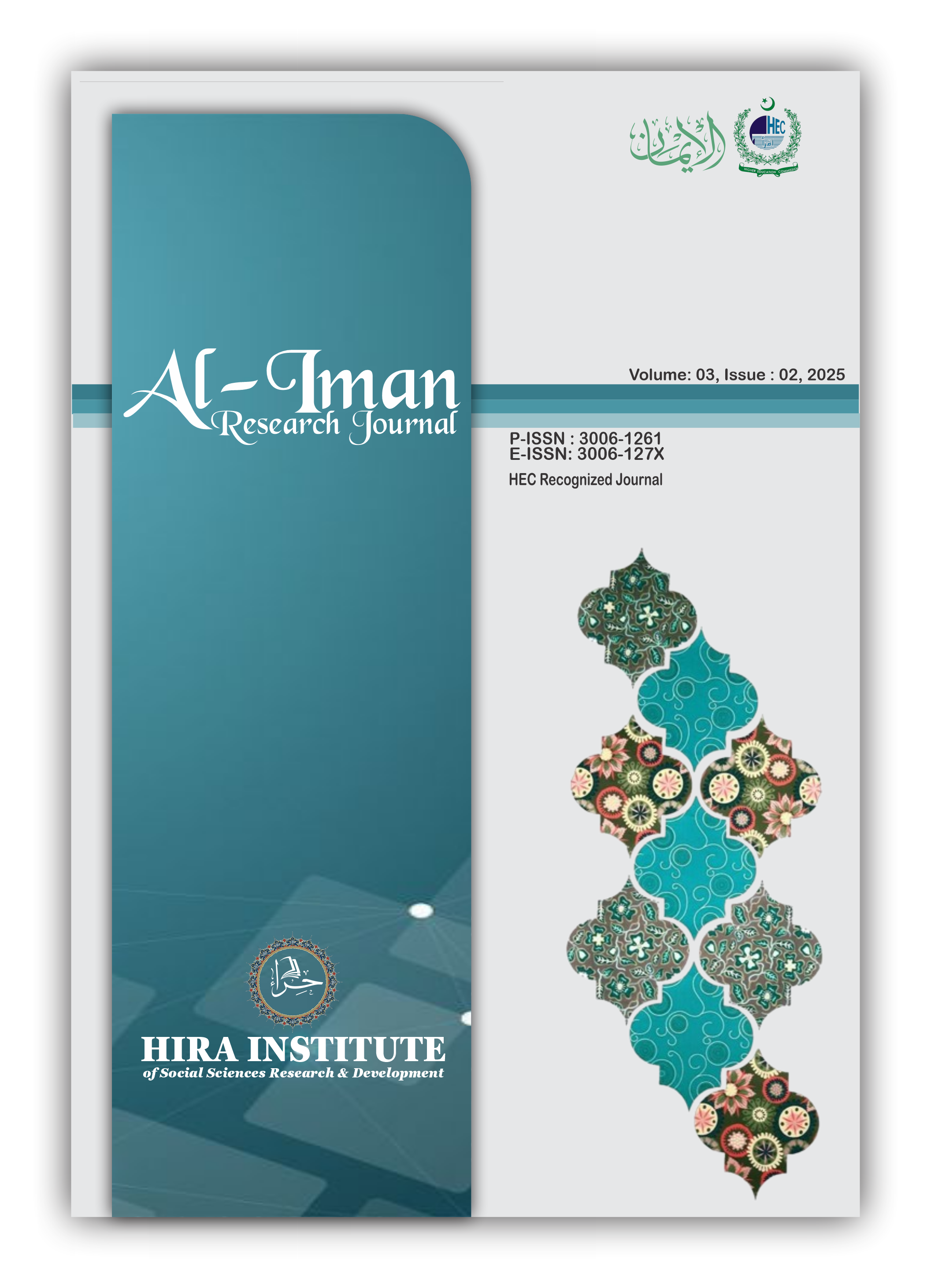Prevailing Catatonia Features Among Children with Autism Spectrum Disorder
Keywords:
Autism Spectrum Disorder, Catatonia, Special Education, DSM-5, Catatonic Features, Mutism, Negativism, Descriptive SurveyAbstract
This study aimed to investigate the prevalence of catatonia features among children with Autism Spectrum Disorder (ASD) in Faisalabad's special education institutes. A quantitative, descriptive survey design was adopted. A 30-item questionnaire, based on DSM-5 criteria for catatonia, was developed and administered to 34 special education teachers selected through convenience sampling. The target population included teachers working directly with children diagnosed with ASD. Catatonia was identified through the presence of at least three symptoms such as catalepsy, waxy flexibility, stupor, mutism, negativism, agitation, posturing, stereotypy, mannerisms, grimacing, echolalia, and echopraxia. Researchers obtained formal permission from school administrations and introduced the study objectives to participating teachers. Each teacher was asked to observe and assess one specific student with ASD using the questionnaire. After one week of observation, completed questionnaires were collected for analysis. Only teachers who had spent considerable time with the students were included in the study to ensure reliable observations. Data were analyzed using descriptive statistics. The results revealed that negativism and mutism were the most frequently observed catatonic features among students with ASD. Agitation, waxy flexibility, and posturing were observed at moderate levels. Echolalia, stupor, and stereotypy were less common, while mannerisms, echopraxia, grimacing, and catalepsy appeared rarely. The findings indicate that while a wide range of catatonia symptoms can be present in children with ASD, certain features—particularly negativism, mutism, agitation, and waxy flexibility—are more prominent.
References
American Psychiatric Association. (2013). Diagnostic and statistical manual of mental disorders. 5th ed. Arlington, TX: American Psychiatric Association.
Baio, J., Wiggins, L., Christensen, D.L., Maenner, M.J., Daniels, J. (2020). Prevalence of Autism Spectrum Disorder Among Children Aged 8 Years-Autism and Developmental Disabilities Monitoring Network, 11 Sites, United States, 2014. MMWR Surveill Summ, 69(4),1-12.
Benarous, X., Raffin, M., Ferrafiat, V., Consoli, A., & Cohen, D. (2018). Catatonia in children and adolescents: new perspectives. Schizophrenia Research, 200, 56-67.
Breen, J., & Hare, D. J. (2017). The nature and prevalence of catatonic symptoms in young people with autism. Journal of Intellectual Disability Research, 61(6), 580-593.
Christensen, D.L., Baio, J., Braun, K.V.N., Bilder, D., Charles, J…….Yearing-Alsopp (2016). Prevalence and Characteristics of Autism Spectrum Disorder Among Children Aged 8 Years-Autism and Developmental Disabilities Monitoring Network, 11 Sites, United States, 2012. Morbidity and Mortality Weekly Report. Surveill Summ, 65(1), 1-23.
Cornic, F., Consoli, A., Tanguy, M. L., Bonnot, O., Périsse, D., Tordjman, S., ... & Cohen, D. (2009). Association of adolescent catatonia with increased mortality and morbidity: evidence from a prospective follow-up study. Schizophrenia research, 113(2-3), 233-240.
Cleveland Clinic (2024). Catatonia. https://my.clevelandclinic.org/health/diseases/23503-catatonia.
DeJong, H., Bunton, P., & Hare, D. J. (2014). A systematic review of interventions used to treat catatonic symptoms in people with autistic spectrum disorders. Journal of Autism and Developmental Disorders, 44, 2127-2136.
Dhossche, D. (2014). Decalogue of catatonia in autism spectrum disorders. Frontiers in Psychiatry, 5, 157-162.
Dhossche, D. M. (2019). Catatonia in Autism Spectrum Disorders: Diagnosis, Therapy, and Clinical Science. Autism and developmental disorders, 17(1), 24-35.
Dhossche, D. M., Stoppelbein, L., & Rout, U. K. (2010). Etiopathogenesis of catatonia: generalizations and working hypotheses. The journal of ECT, 26(4), 253-258.
Ghaziuddin, N., Andersen, L., & Ghaziuddin, M. (2021). Catatonia in patients with autism spectrum disorder. Psychiatric Clinics, 44(1), 11-22.
Gowen, E., & Hamilton, A. (2013). Motor abilities in autism: a review using a computational context. Journal of Autism Developmental Disorder, 43(2),323–44.
Hare, D. J., & Malone, C. (2004). Catatonia and autistic spectrum disorders. Autism, 8(2), 183-195.
Hirjak, D., Foucher, J. R., Ams, M., Jeanjean, L. C., Kubera, K. M., Wolf, R. C., & Northoff, G. (2024). The origins of catatonia–Systematic review of historical texts between 1800 and 1900. Schizophrenia research, 263, 6-17.
Kern, J.K., Trivedi, M.H., Garver, C.R., Grannemann, B.D., Andrews, A.A., Savla, J.S. (2006). The pattern of sensory processing abnormalities in autism. Autism, 10(5), 480–94.
Moore, S., Amatya, D. N., Chu, M. M., & Besterman, A. D. (2022). Catatonia in autism and other neurodevelopmental disabilities: a state-of-the-art review. Npj Mental Health Research, 1(1), 12.
Nadeem, N. J., Moawad, A., Howatson, S., Ahmed, A., & Cassell, D. (2024). Case report: Diagnostic challenges in an adolescent case of autistic catatonia. Frontiers in Psychiatry, 15, 1386949.
Shah, A. (2016). Catatonia and catatonia-type breakdown in autism. https://network.autism. org.uk/good-practice/evidence-base/catatonia-and-catatonia-type-breakdown-autism
Shah, A., & Wing, L. (2006). Psychological approaches to chronic catatonia-like deterioration in autism spectrum disorders. International Review of Neurobiology, 72, 245-264.
Traverso, A., Ancora, C., Zanato, S., Raffagnato, A., & Gatta, M. (2021). Diagnostic and therapeutic challenges of catatonia in an adolescent with high functioning autism spectrum disorder: a case report. Frontiers in Psychiatry, 12, 644727.
Vaquerizo-Serrano, J., Salazar De-Pablo, G., Singh, J, & Santosh, P. (2022). Catatonia in autism spectrum disorders: A systematic review and meta-analysis. European Psychiatry, 65(1), e4, 1–10.
Wachtel, L. E. (2019). Treatment of catatonia in autism spectrum disorders. Acta Psychiatrica Scandinavica, 139(1), 46-55.
Wing, L., & Shah, A. (2000). Catatonia in autistic spectrum disorders. The British journal of psychiatry : the journal of mental science, 176, 357–362. https://doi.org/10.1192/bjp. 176. 4.357
Withane, N., & Dhossche, D. M. (2018). Electroconvulsive Treatment for Catatonia in Autism Spectrum Disorders. Child and Adolescent Psychiatric Clinics of North America, 28(1), 101-110.
Yeargin-Allsopp, M., Rice, C., Karapurkar, T., Doernberg, N., Boyle, C., & Murphy, C. (2003). Prevalence of autism in a US metropolitan area. Jama, 289(1), 49-55.
Yurumez, E., Temelturk, R. D., Kaymak, B., Karabıyıkoğlu, Y. Ö., & Zengin, N. D. (2024). Catatonia in autism spectrum disorders: Prevalence, functional impact, and diagnostic insights. Psychiatry research, 342, 116250. https://doi.org/10.1016/j.psychres. 2024. 116250






